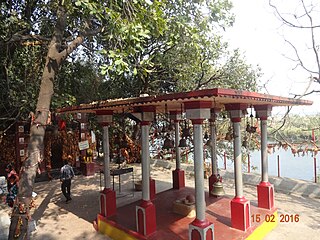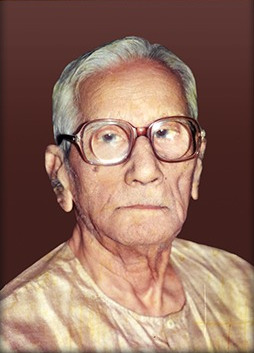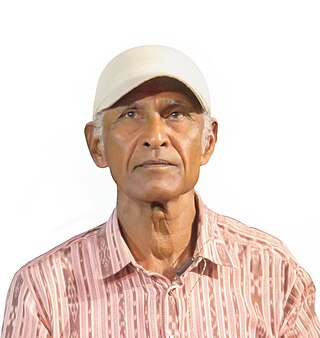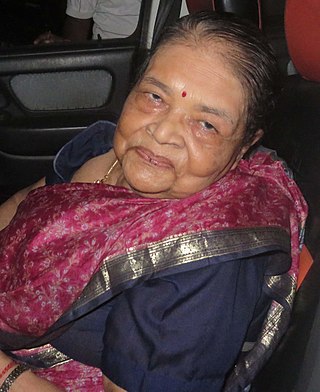Related Research Articles

Sambalpur District is a district in the western part of state of Odisha, India. The historic city of Sambalpur is the district headquarters.
Sambalpur is the fifth largest city in the Indian State of Odisha. It is located on the banks of river Mahanadi, with a population of 335,761. Prehistoric settlements have been recorded there. It is the home of the Sambalpuri sari.

Sambalpur University is a public research university located in Burla town, of district Sambalpur, India, in the state of Odisha. Popularly known as Jyoti Vihar, it offers courses at the undergraduate and post-graduate levels. The governor of Odisha is the chancellor of the university. The campus is located 15 km away from Sambalpur.
Western Odisha is the western part of the state of Odisha in India, extending from the Kalahandi district in the south to the Sundargarh district in the north.

Sambalpuri is an Indo-Aryan language variety spoken in western Odisha, India. It is alternatively known as Western Odia, and as Kosali, a recently popularised but controversial term, which draws on an association with the historical region of Dakshina Kosala, whose territories also included the present-day Sambalpur region.

Dr. Haldhar Nag is a Sambalpuri poet and writer from Bargarh, Odisha, India. Popularly known as "Lok Kabi Ratna". He was awarded Padma Shri, the fourth highest civilian award of India by Government of India in 2016. He was born in a poor family of Ghens. He is best known for his work Kavyanjali, an anthology of English translation of Nag's selected poetry which was launched on 2 October 2016. Recently he released his 3rd volume of work on Kavyanjali. In 2019, Haldhar Nag was awarded Doctorate Degree by Sambalpur University. In the year 2020, Professor Jaishankar Babu, Head of the Department of Hindi, Pondicherry University, organized a two-day international seminar under the guidance of its Vice-Chancellor Professor Gurmeet Singh, in which "Haldhar Nag Ka kavya- Sansar" translated into Hindi from Sambalpuri by renowned Hindi writer-transaltor Dinesh Kumar Mali was released and there was an intensive discussion on his poems by the participants from India and abroad. In the year 2021, under the joint editorship of Professor Jaishankar Babu and translator Dinesh Kumar Mali, the book "'Haldhar ke Lok-sahitya par vimarsh'" and the book "Ramayan prasangon par Haldhar ke Kavya aur yugin Vimarsh " translated by Dinesh Kumar Mali based on Ramayana contexts. published from Pandulipi Prakashan, New Delhi.The popularity of these books Hindi Belt honoured Haldhar Nag with Dr Ram Manohar Tripathi Lok Seva Samman on the Silver Jubilee eve of Acharya Mahavir Prasad Dwivedi Smruti Sanrakshan Abhiyan under the leadership of Gaurav Awasthi in the auditorium of Firoz Gandhi College, Rae Bareli on date 12.11.22. The Indira Gandhi National Open University (IGNOU) has included a review of the literary creations of Padma awardee and noted poet Haldhar Nag. According to sources, students pursuing a Master of Arts (MA) in Folklore and Culture Studies will study folk literature by Nag in a course component titled, ‘Folklore: Canon, Multimediality, Interdisciplinarity, and Social Epistemology’ in their second year. The course book has described Nag as the true representative of orality in the present times. His creations have been reviewed in the category, ‘Case study of orality from East India’.“Nag has based his poems on his surroundings. Folklorists and folklore researchers are vulnerable to multiple challenges with regards to archiving, documentation, and dissemination of the folk material,” TOI reported writer Nandini Sahu, who has designed the MA course for IGNOU, as saying. Notably, writer Dinesh K Mali has written a chapter for the MA programme on Nag’s poetry.'
Sambalpur, in Orissa, India, is a region that has a distinct cultural identity. The songs, clothing, dances, language and festivals celebrated in Sambalpur are unique. This distinct cultural identity arises from the strong association of the tribal and folk communities which have been coexisting in Sambalpur for centuries.

Parbati Giri, daughter of Dhananjay Giri. Nicknamed the Mother Teresa of Western Odisha, was a prominent female freedom fighter from Odisha, India. The women freedom fighters of Odisha played a significant role in the Indian Freedom Struggle.
Several folk dance forms evolved in different regions of Odisha, Odissi and Chhau being some popular forms. Sambalpuri dance is most popular dance of western Odisha and is enjoyed by many.
"Rangabati" is perhaps the most popular recorded song in Sambalpuri Odia. Krishna Patel, a 2023 Padma Shri awardee, is the female singer while the male singer Jitendra Haripal is a 2017 Padma Shri awardee. The song was first recorded for All India Radio in the mid-1970s. A record company from the then Calcutta, Indian Record Manufacturing Company Ltd (INRECO), re-recorded the song in 1976. The disc release was delayed due to a dispute and finally released in 1978–79. The Sambalpuri song was written by Mitrabhanu Gauntia, composed by Prabhudatta Pradhan and sung by Jitendra Haripal and Krishna Patel. In the 1970s and 1980s, the song gained popularity for being commonly played in marriage processions and Murti immersion. The song gained official recognition when it was played in the tableau of Odisha as part of the Republic Day celebrations at New Delhi in 2007. The lead singer Jitendra Haripal was also felicitated by Odisha Chief Minister Naveen Patnaik later that year. It was also notably used in the celebration of victory during an international cricket match in Barabati Stadium, Cuttack. "Rangabati" was recreated in many other languages of India and has been recreated in Telugu for a movie.

Kailash Chandra Meher is an Indian artist, inventor, and social activist. He is a painter of contemporary modern art paintings and traditional Tussar Pattachitra paintings of Odisha. He was a recipient of the Padma Shri by the Government of India in 2013.

Dr. Radhanath Rath was a newspaper editor, freedom fighter, social worker and politician from Odisha. He was the editor of The Samaja, one of the leading newspapers of Odisha.

Prafulla Kar was an Odia musician, singer, lyricist, writer and columnist. He received Padma Shri, the fourth highest civilian award by the Government of India in 2015 for his contribution in the field of arts.
Isaac Santra was an Indian physician, gandhian and social worker, known for his contributions for the eradication of Leprosy from India. The Government of India honoured him in 1956, with the award of Padma Shri, the fourth highest Indian civilian award for his services to the nation.

Jitendra Haripal, a singer, is most popularly known for his voice in the famous and super hit Rangabati Song in Sambalpuri language of Odisha. He sang this duet song with his female co-singer Krishna Patel. He has sung over 1000 songs and regarded as a top exponent of Sambalpuri language song. He has shared the stage with other leading artists of the State including the former Chief Minister Giridhar Gamang, himself a fine musician. He received the Padma Shri, the fourth highest civilian award of India from the Government of India in 2017 for his contribution to the Indian Music.

Laxminarayan Mishra was a supporter of Indian independence and writer from Odisha, India. He was one of the most active nationalists of Western Odisha.

Binapani Mohanty was an Indian Odia language writer and academician. She was well known for her works such as Patadei and Kasturi Mriga. She was a professor in economics before retiring. She had been awarded Padmashree by the Government of India and Atibadi Jagannatha Das Sammana by Odisha Sahitya Akademi. She had earlier won the Sahitya Akademi Award and Sarala Award. She had served as chairperson of Odisha Lekhika Sansad.

Shyamamani Devi is a Odissi classical music vocalist composer. A disciple of Gurus Singhari Shyamsundar Kar and Balakrushna Dash, she is known for her popular renditions of classical Odissi music, such as Odissi, Chhanda, Champu, etc. authored by medieval Odia musician-poets such as Upendra Bhanja, Kabisurjya Baladeba Ratha, Banamali Dasa, Gopalakrusna and others. She is also known for her renditions of light music such as traditional Odia folk music ,Odia film music and adhunika songs. In 2022, she was awarded the Padma Shri for he contributions to Odissi music.
Narasingha Prasad Guru is an author and a lyricist from the Indian State of Odisha. He is a pioneer and a promoter of the Koshali language, also known as the Sambalpuri language, which is a language spoken in the western parts of Odisha. He has composed over 10 books in this language and composed around 500 songs. He has also compiled a dictionary of the Koshali language.

Shanti Devi was an Indian social worker born in 1934 in Balasore district of Indian state of Odisha. She was awarded the Padma Shri award on 9 November 2021 by the President, Ram Nath Kovind at the Civil Investiture Ceremony-IV, at Rashtrapati Bhavan for her social works and efforts to bring peace in the Maoist-affected Rayagada region of Odisha. Devi received the Radhanath Rath Peace Award and was awarded the Jamnalal Bajaj Award in 1994.
References
- 1 2 3 4 5 "Odisha's 'Rangabati' duo brings in two Padma awards". The New Indian Express. Retrieved 2020-11-29.
- 1 2 "'Rangabati' fame Sambalpuri folksong writer has a dream - OrissaPOST". Odisha News, Odisha Latest news, Odisha Daily - OrissaPOST. 2020-01-31. Retrieved 2020-11-29.
- 1 2 3 "PRIDE OF THE NATION - OrissaPOST". Odisha News, Odisha Latest news, Odisha Daily - OrissaPOST. 2020-02-03. Retrieved 2020-11-29.